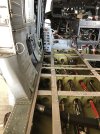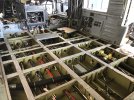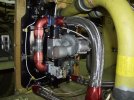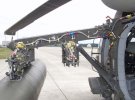Another couple factors to consider on 'should' the MH-60S have a probe for HAAR capability.
What organic tanker is there in the Navy that can provide HAAR? None. So who is going to provide us HAAR....
For the 160th they rely primarily on AFSOC MH-130's which are fragged through SOCOM. So that is their dedicated tanker.
The USAF RQS deployment consists of a package with HC-130's, HH-60Gs and PJs. Of note, a "RQS" (Rescue) squadron is either a HH-60G squadron, HC-130 squadron, or PJ squadron (unlike Navy where we HSC, HSM, VFA, is essentially a platform). So again, HH-60Gs have organic dedicated tanking within USAF Combat Rescue.
Marines have their KC-130's for ADGR and for HAAR (if that's what the Osprey nerds call it) to support their expeditionary life style and the rest of the MEU.
That said, if we had a probe to conduct HAAR, it doesn't mean that we would have to have a dedicated tanker, but it sure makes it a lot harder to stay qualified or have on call mission support. Perhaps VR wants to start using those KC-130T's to support HSC if we got a probe! hahaha nope
In the future MCO fight, the question is does the MH-60S need HAAR capability as a mission requirement to support the customer?
What organic tanker is there in the Navy that can provide HAAR? None. So who is going to provide us HAAR....
For the 160th they rely primarily on AFSOC MH-130's which are fragged through SOCOM. So that is their dedicated tanker.
The USAF RQS deployment consists of a package with HC-130's, HH-60Gs and PJs. Of note, a "RQS" (Rescue) squadron is either a HH-60G squadron, HC-130 squadron, or PJ squadron (unlike Navy where we HSC, HSM, VFA, is essentially a platform). So again, HH-60Gs have organic dedicated tanking within USAF Combat Rescue.
Marines have their KC-130's for ADGR and for HAAR (if that's what the Osprey nerds call it) to support their expeditionary life style and the rest of the MEU.
That said, if we had a probe to conduct HAAR, it doesn't mean that we would have to have a dedicated tanker, but it sure makes it a lot harder to stay qualified or have on call mission support. Perhaps VR wants to start using those KC-130T's to support HSC if we got a probe! hahaha nope
In the future MCO fight, the question is does the MH-60S need HAAR capability as a mission requirement to support the customer?






 . HSC will need a new mission to dream about once born-again VRC gets tactical with their Ospreys and snatches up CSAR/SOF/etc.
. HSC will need a new mission to dream about once born-again VRC gets tactical with their Ospreys and snatches up CSAR/SOF/etc.